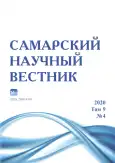Contemporary art in the development of a gifted child’s art-aesthetic thesaurus
- Authors: Kalinina L.Y.1, Ivanov D.V.1, Nikitin N.A.1
-
Affiliations:
- Samara State University of Social Sciences and Education
- Issue: Vol 9, No 4 (2020)
- Pages: 301-306
- Section: Pedagogical Sciences
- URL: https://journals.rcsi.science/2309-4370/article/view/59502
- DOI: https://doi.org/10.17816/snv202094306
- ID: 59502
Cite item
Full Text
Abstract
The authors substantiate the expediency of referring to the forms and artistic means of contemporary art as integrating mechanisms of the semantic space common to adult authors and children who are passionate about creativity. According to the most important understanding of childhood in the thesaurus approach – according to Val.A. Lukov, the preserved past – in its correlation with the peculiarities of the children’s subculture, the idea of matching the spontaneous creative actions of the child and the well-thought-out creative method of modern authors who seek to show the creative process itself is justified. The contradiction between the fundamental difference of the adults and children’ thinking models disappears when the child in the game acts «on behalf of the Contemporary Author», showing his talent as actions to structure the fruitful disorder of an unfamiliar educational environment. The thesaurus helps to discover new meanings – an accumulated body of knowledge about the world and how it is reflected in art products, sufficient for orientation in this environment. Taking into account the complex effects of the digital age on the child from the real and virtual subspaces, the presence in his thesaurus of contemporary art concepts, embodied in words, visual and musical images, it will contribute to a bright, obvious manifestation of giftedness at the age of 6–7 years.
Full Text
##article.viewOnOriginalSite##About the authors
Larisa Yurievna Kalinina
Samara State University of Social Sciences and Education
Author for correspondence.
Email: kalinina@pgsga.ru
candidate of pedagogical sciences, associate professor of Preschool Education Department
Russian Federation, SamaraDmitry Viktorovich Ivanov
Samara State University of Social Sciences and Education
Email: ivanov@pgsga.ru
candidate of psychological sciences, associate professor of Pedagogy and Psychology Department
Russian Federation, SamaraNikolay Aleksandrovich Nikitin
Samara State University of Social Sciences and Education
Email: nikitin_nikolai@inbox.ru
manager of Research Department
Russian Federation, SamaraReferences
- Путин В.В. Послание Федеральному собранию 2019 [Электронный ресурс] // Российская газета. – https://rg.ru/2019/02/20/stenogramma-poslaniia-vladimira-putina-federalnomu-sobraniiu.html.
- Указ о национальных целях развития России до 2030 года [Электронный ресурс] // http://www.kremlin.ru/events/president/news/63728.
- Богоявленская Д.Б. Теоретико-методологические основания раскрытия природы одаренности // Психология творчества и одаренности: мат-лы всерос. науч.-практ. конф., г. Москва, 20–21 апреля 2018 г.: сб. ст. / отв. ред. Д.Б. Богоявленская. М.: Изд-во МПГУ, 2018. С. 21–26.
- Луков Вал.А., Луков Вл.А. Тезаурусы: науч. монография. М.: Издательство Национального института бизнеса, 2008. 784 с.
- Язык – система. Язык – текст. Язык – способность: к 60-летию члена-корреспондента Российской академии наук Юрия Николаевича Караулова. М.: Ин-т рус. языка РАН, 1995. 287 с.
- Пономарев Я.А., Гаджиев Ч.М. Закономерности общения в творческом коллективе // Вопросы психологии. 1986. № 6. С. 77–87.
- Калинина Л.Ю., Иванов Д.В. Технология раннего выявления одаренности средствами современного искусства: учебно-методическое пособие / под ред. Н.Г. Кочетовой. Самара: Издательство «Артель», 2019. 180 с.
- Современное искусство и отечественный художественный рынок: монография / под ред. Т.Е. Шехтер. СПб.: СПбГУП, 2005. 176 с.
- Eco U. Opera aperta. Italy, Milano: Bompiani, 1962. 370 p.
- Раннее выявление одаренности в условиях художественно-творческого процесса: монография. Ч. I / отв. ред. Л.Ю. Калинина, Д.В. Иванов. Самара: Изд-во «Артель», 2018. 160 с.
- Цехмистренко Т.А., Васильева В.А., Обухов Д.К., Шумейко Н.С. Строение и развитие коры большого мозга. М.: Издательство «Спутник+», 2019. 559 с.
- Делёз Ж., Гваттари Ф. Ризома // Философия постмодерна: сб. переводов и рефератов / отв. ред. А.Р. Усманова. Мн.: Изд-во «Красико-Принт», 1996. 207 с.
- Теплов Б.М. Психология музыкальных способностей // Психология музыки и музыкальных способностей: хрестоматия / сост.-ред. А.Е. Тарас. М.: АСТ; Мн.: Харвест, 2005. С. 15–360.
- Калинина Л.Ю. Синтез искусств в современном художественно-эстетическом образовании: Теоретические основы и технология арт-композиции: монография. Самара: Издательство «Артель», 2017. 268 с.
- Bezruczko N. Is DNA expression generative art? // 20th generative art conference. Ravenna, Italy, 2017. P. 256–288.
- Шириева Н.В., Дыганова Е.А. «По мотивам татарского фольклора» Софии Губайдулиной: к проблеме интертекстуальности // Вестник Кемеровского государственного университета культуры и искусств. 2016. № 37–2. С. 93–101.
- Дубровинская Н.В., Фарбер Д.А. Формирование механизмов мозгового обеспечения когнитивных процессов в дошкольном возрасте // Психофизиология матери и ребенка: нервная система: межвуз. сб. / под ред. акад. РАО, д-ра биол. наук А.С. Батуева. Вып. 33. СПб.: Издательство Санкт-Петербургского государственного университета, 1999. С. 124–145.
- Привалова В.М. Орнамент как знаково-символический язык ритуалов культуры: монография. Самара: Изд-во СамНЦ РАН, 2015. 236 с.
- Ceplitis A. The friction of aesthetics and narrative taxonomy in 360° films // 4th International Multidisciplinary Scientific Conference on Social Sciences and Arts SGEM 2017. 2017 March 28–31. Book 6. Vol. 1. Sofia, Bulgaria, 2017. P. 477–484.
- Glaveanu V.P. Educating which creativity? // Thinking Skills and Creativity. 2018. Vol. 27. P. 25–32.
Supplementary files






